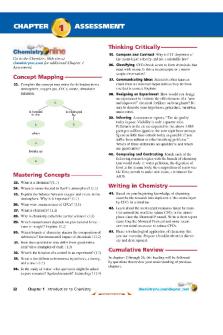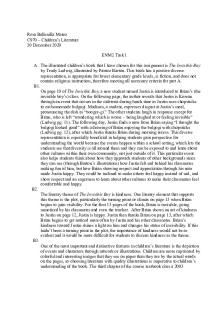Part C - Assessment 1 PDF

| Title | Part C - Assessment 1 |
|---|---|
| Author | albina borodina |
| Course | Management Accounting |
| Institution | Queensland University of Technology |
| Pages | 3 |
| File Size | 80.9 KB |
| File Type | |
| Total Downloads | 10 |
| Total Views | 175 |
Summary
Assessment 1...
Description
AYB225 ASSIGNMENT PART C (2 full pages maximum, 1.5 spaced, excluding References)
After careful analysis of the data from schedule 6 and appropriate literature, the issue of insufficiency of the existing costing system of Sneakers Unlimited arose. Hence, the choice of implementing ABC (Activity-Based Costing) system or keeping the current one is to be made. As stated in the case study, the existing costing system of Sneakers Unlimited was established when only one type of shoes was produced and when overhead was significantly smaller proportion of total costs than it is now. Traditional product costing system is perfect for the companies manufacturing a narrow range of products, where direct labour and materials are the dominant factory costs (Drury, 1992). However, nowadays the business sells multiple product lines: dance, run and walk, where direct labour represents only a small friction of total costs and overhead costs are of considerable importance (Drury, 1992). Based on the data from schedule 6, overhead unit costs for the Dance range are higher under the current costing system in comparison with ABC costing system: $23.00 versus $13.57 respectively. Under the existing traditional costing system used by Sneakers Unlimited, allocation of overhead costs is based on labour or machine hours, which are unlikely to be the root cause of the manufacturing overhead. Moreover, traditional costing system often overlooks expenses which are treated as fixed cost, like research and development, distribution and sales (Taylor, 2002). In the meantime, it can be seen from schedule 6 that distribution of overhead costs in ABC system is based on the activity levels like design hours, number of purchase orders and number of tests. It gives managers an opportunity to calculate price and measure overhead, which constitutes the major element of production cost, for each item more precisely. Thereafter, confidence in setting up the right pricing strategy will lead to making more advantageous decisions, like ending the production of unprofitable lines to introduce the new ones. Finally, the company will certainly gain a competitive advantage on the market as it will use resources more effectively. Even though implementation of ABC costing system may require additional cost it might be worth adopting (Kaplan and Anderson, 2004). Investing in a costing system that will help to set up the product prices correctly will help the firm to reduce wastage and improve the current processes. For instance, under the existing costing system overhead costs per unit for Run and Walk lines are much lower than overhead costs per unit under the ABC costing system: $18.40 and $34.50 versus $21.90 and $71.02 respectively. Obviously, the company
Page 1
AYB225 ASSIGNMENT PART C (2 full pages maximum, 1.5 spaced, excluding References)
cannot set correct prices for the products relying on under costing of overhead information. The numbers presented before basically show that Sneakers Unlimited underestimates the real cost of products when setting the selling prices, which means that production of the line consumes large amount of resources but is reported to have a low cost (Kaplan and Anderson, 2004). Therefore, the business will experience future losses. It is strongly recommended for Sneakers Unlimited to implement ABC costing system due to the fact that the current one gives management the wrong vision of the actual situation in the company. Implementing ABC costing system will help the firm to improve current processes, help to reduce costs and make better financial decisions based on more accurate information.
Page 2
AYB225 ASSIGNMENT PART C (2 full pages maximum, 1.5 spaced, excluding References)
References Drury, C. (1992). Management and Cost Accounting. Pp.273-288. Taylor, L. J. (2002). Activity-based costing: Why your company can’t succeed without it. Pp. 50-53. Kaplan, R. and Anderson, S. (2004). Time-Driven Activity-Based Costing. Harvard Business Review, [online] (11). Available at: https://hbr.org/2004/11/time-driven-activity-based-costing [Accessed 9 Oct. 2016].
Page 3...
Similar Free PDFs

Part C - Assessment 1
- 3 Pages

Module 1 - Assessment Part 1
- 2 Pages

Part 1 - Earthquake Assessment A
- 12 Pages

Part C Cover Letter
- 1 Pages

Health Assessment Vocab C
- 1 Pages

Assessment 2 - Part 2
- 3 Pages

Assessment 5 part 2
- 1 Pages

Bsbsus 201 Assessment 1 Part A
- 5 Pages

MGT501 Assessment 1 Part B Brief
- 7 Pages
Popular Institutions
- Tinajero National High School - Annex
- Politeknik Caltex Riau
- Yokohama City University
- SGT University
- University of Al-Qadisiyah
- Divine Word College of Vigan
- Techniek College Rotterdam
- Universidade de Santiago
- Universiti Teknologi MARA Cawangan Johor Kampus Pasir Gudang
- Poltekkes Kemenkes Yogyakarta
- Baguio City National High School
- Colegio san marcos
- preparatoria uno
- Centro de Bachillerato Tecnológico Industrial y de Servicios No. 107
- Dalian Maritime University
- Quang Trung Secondary School
- Colegio Tecnológico en Informática
- Corporación Regional de Educación Superior
- Grupo CEDVA
- Dar Al Uloom University
- Centro de Estudios Preuniversitarios de la Universidad Nacional de Ingeniería
- 上智大学
- Aakash International School, Nuna Majara
- San Felipe Neri Catholic School
- Kang Chiao International School - New Taipei City
- Misamis Occidental National High School
- Institución Educativa Escuela Normal Juan Ladrilleros
- Kolehiyo ng Pantukan
- Batanes State College
- Instituto Continental
- Sekolah Menengah Kejuruan Kesehatan Kaltara (Tarakan)
- Colegio de La Inmaculada Concepcion - Cebu






